Potřebujeme váš souhlas k využití jednotlivých dat, aby se vám mimo jiné mohly ukazovat informace týkající se vašich zájmů. Souhlas udělíte kliknutím na tlačítko „OK“.
ASTM E452-02(2013)
Standard Test Method for Calibration of Refractory Metal Thermocouples Using a Radiation Thermometer
Automaticky přeložený název:
Standardní zkušební metoda pro kalibraci Žárovzdorná kovová termočlánky pomocí radiační teploměr
NORMA vydána dne 1.5.2013
Informace o normě:
Označení normy: ASTM E452-02(2013)
Poznámka: NEPLATNÁ
Datum vydání normy: 1.5.2013
Kód zboží: NS-46834
Počet stran: 14
Přibližná hmotnost: 42 g (0.09 liber)
Země: Americká technická norma
Kategorie: Technické normy ASTM
Kategorie - podobné normy:
Anotace textu normy ASTM E452-02(2013) :
Keywords:
high-temperature calibration, optical pyrometer, radiation thermometer, refractory metal thermocouple, thermocouple, thermocouple calibration, vacuum furnace, ICS Number Code 17.200.20 (Temperature-measuring instruments)
Doplňující informace
| Significance and Use | ||||||||||
|
5.1 This test method is intended to be used by wire producers and thermocouple manufacturers for certification of refractory metal thermocouples. It is intended to provide a consistent method for calibration of refractory metal thermocouples referenced to a calibrated radiation thermometer. Uncertainty in calibration and operation of the radiation thermometer, and proper construction and use of the test furnace are of primary importance. 5.2 Calibration establishes the temperature-emf relationship for a particular thermocouple under a specific temperature and chemical environment. However, during high temperature calibration or application at elevated temperatures in vacuum, oxidizing, reducing or contaminating environments, and depending on temperature distribution, local irreversible changes may occur in the Seebeck Coefficient of one or both thermoelements. If the introduced inhomogeneities are significant, the emf from the thermocouple will depend on the distribution of temperature between the measuring and reference junctions. 5.3 At high temperatures, the accuracy of refractory metal thermocouples may be limited by electrical shunting errors through the ceramic insulators of the thermocouple assembly. This effect may be reduced by careful choice of the insulator material, but above approximately 2100 °C, the electrical shunting errors may be significant even for the best insulators available. |
||||||||||
| 1. Scope | ||||||||||
|
1.1 This test method covers the calibration of refractory metal thermocouples using a radiation thermometer as the standard instrument. This test method is intended for use with types of thermocouples that cannot be exposed to an oxidizing atmosphere. These procedures are appropriate for thermocouple calibrations at temperatures above 800 °C (1472 °F). 1.2 The calibration method is applicable to the following thermocouple assemblies: 1.2.1 Type 1—Bare-wire thermocouple assemblies in which vacuum or an inert or reducing gas is the only electrical insulating medium between the thermoelements. 1.2.2 Type 2—Assemblies in which loose fitting ceramic insulating pieces, such as single-bore or double-bore tubes, are placed over the thermoelements. 1.2.3 Type 2A—Assemblies in which loose fitting ceramic insulating pieces, such as single-bore or double-bore tubes, are placed over the thermoelements, permanently enclosed and sealed in a loose fitting metal or ceramic tube. 1.2.4 Type 3—Swaged assemblies in which a refractory insulating powder is compressed around the thermoelements and encased in a thin-walled tube or sheath made of a high melting point metal or alloy. 1.2.5 Type 4—Thermocouple assemblies in which one thermoelement is in the shape of a closed-end protection tube and the other thermoelement is a solid wire or rod that is coaxially supported inside the closed-end tube. The space between the two thermoelements can be filled with an inert or reducing gas, or with ceramic insulating materials, or kept under vacuum. 1.3 This standard does not purport to address all of the safety concerns, if any, associated with its use. It is the responsibility of the user of this standard to establish appropriate safety and health practices and determine the applicability of regulatory limitations prior to use. |
||||||||||
| 2. Referenced Documents | ||||||||||
|
Podobné normy:
Historická
1.11.2010
Historická
1.5.2010
Historická
1.6.2009
Historická
15.9.2013
Historická
1.4.2013
Historická
1.3.2014


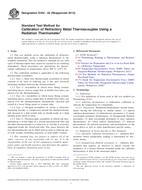
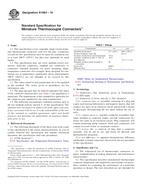 ASTM E1684-10
ASTM E1684-10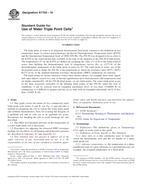 ASTM E1750-10
ASTM E1750-10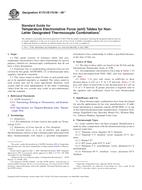 ASTM E1751/E1751M-09..
ASTM E1751/E1751M-09..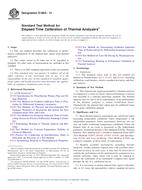 ASTM E1860-13
ASTM E1860-13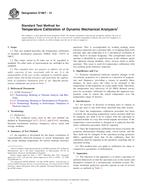 ASTM E1867-13
ASTM E1867-13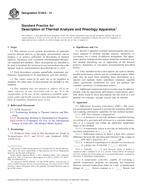 ASTM E1953-14
ASTM E1953-14
 Cookies
Cookies
